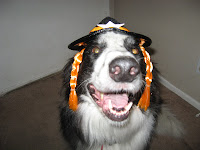
Halloween is full of fun things for you and your family to enjoy, but it's one of those holidays that is enjoyed more by people than by pets. Keep the following precautions in mind when preparing for the frightfully fun festivities and help ensure that everyone in your family - including your pet - has a safe Halloween.
Keep your pet in a quiet place, away from trick-or-treaters and other Halloween activities. You may know that the monsters and goblins who come knocking on Halloween aren't real, but pets don't. In addition, frequently opened doors provide a perfect opportunity for escape, which can go unnoticed during all the commotion. Be sure all pets are wearing collars and ID tags in case of an accidental getaway.
Cats--black ones in particular--often fall victim to pranksters. Keep cats safely indoors. Visit www.humansociety.org/safecats for more information.
Place live flame decorations like candles and jack-o'-lanterns out of your pet's reach. Curious critters risk being singed or burned by the flame--they could also easily knock over a candle or pumpkin and cause a fire.
Keep candy away from pets. All those sweets may taste great to pets, but candy, especially chocolate, can be toxic to pets. Candy wrappers can also be harmful if swallowed. Raisins are also toxic. Candy and gum sweetened with Xylitol can be deadly.
Don't let the family dog accompany the kids on their trick-or-treat outing. Your dog can get easily spooked by the strange costumes, sights and sounds of trick-or-treaters. Your dog can get loose and run away.
Keep decorations that pets could chew on--like streamers, fake spiders webs, wires or cords. If pets chomp on Halloween decorations they could choke or become ill. Pets could also become tangled and injured by dangling cords or decorations.
Keep your pet in a quiet place, away from trick-or-treaters and other Halloween activities. You may know that the monsters and goblins who come knocking on Halloween aren't real, but pets don't. In addition, frequently opened doors provide a perfect opportunity for escape, which can go unnoticed during all the commotion. Be sure all pets are wearing collars and ID tags in case of an accidental getaway.
Cats--black ones in particular--often fall victim to pranksters. Keep cats safely indoors. Visit www.humansociety.org/safecats for more information.
Place live flame decorations like candles and jack-o'-lanterns out of your pet's reach. Curious critters risk being singed or burned by the flame--they could also easily knock over a candle or pumpkin and cause a fire.
Keep candy away from pets. All those sweets may taste great to pets, but candy, especially chocolate, can be toxic to pets. Candy wrappers can also be harmful if swallowed. Raisins are also toxic. Candy and gum sweetened with Xylitol can be deadly.
Don't let the family dog accompany the kids on their trick-or-treat outing. Your dog can get easily spooked by the strange costumes, sights and sounds of trick-or-treaters. Your dog can get loose and run away.
Keep decorations that pets could chew on--like streamers, fake spiders webs, wires or cords. If pets chomp on Halloween decorations they could choke or become ill. Pets could also become tangled and injured by dangling cords or decorations.
































